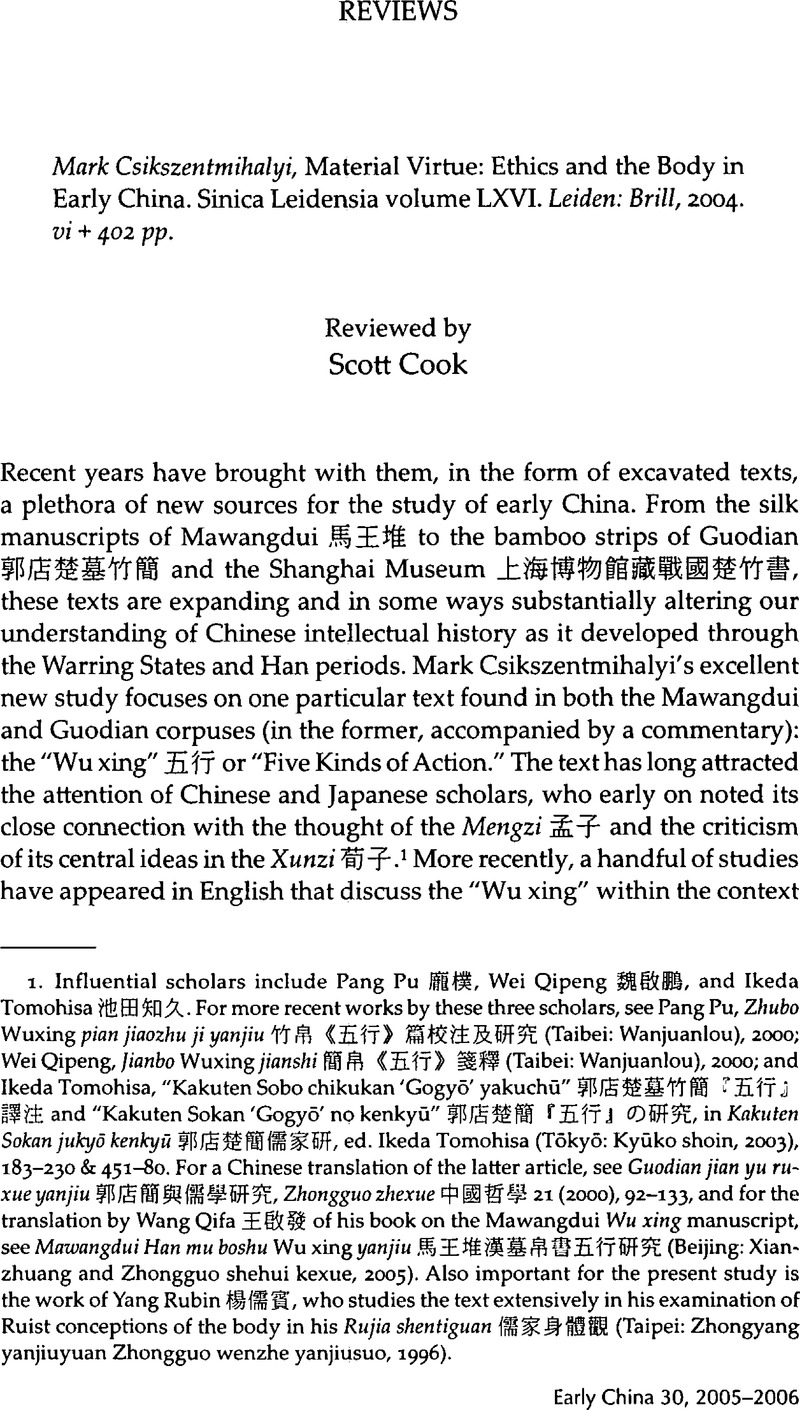No CrossRef data available.
Article contents
Mark Csikszentmihalyi, Material Virtue: Ethics and the Body in Early China. Sinica Leidensia volume LXVI. Leiden: Brill, 2004. vi + 402 pp.
Published online by Cambridge University Press: 26 March 2015
Abstract

- Type
- Reviews
- Information
- Copyright
- Copyright © Society for the Study of Early China 2005
References
1. Influential scholars include Pang Pu 













2. Riegel, Jeffrey, “Eros and Shijing Commentary,” Harvard Journal of Asiatic Studies 57.1 (1997), 143–77CrossRefGoogle Scholar; Csikszentmihalyi, Mark, “Fivefold Virtue: Reformulating Mencian Moral Psychology in Han Dynasty China,” Religion 28 (1998), 77–89Google Scholar; and Cook, Scott, “Consummate Artistry and Moral Virtuosity: the ‘Wu xing 

3. As evidence that statements attributed to Kongzi in the Lun yu were first part of a wide body of diverse sayings that would only retrospectively be linked with “the master,” Csikszentmihalyi cites unattributed versions of these statements found in Guodian “Yucong 3” 
4. See Xianqian, Wang




5. Precisely what aspects of this philosophical tradition remain coherent throughout, how much of that coherence can be traced back directly to either Kongzi himself or the teachings he transmitted, and how much of it was instead imposed through the reconstructions of later-day followers are all matters that remain open to debate. This vast subject of inquiry is obviously deserving of a much fuller treatment than we are able to give it here.
6. Csikszentmihalyi further suggests that the “Wu xing” as we have it may be an “expansion of an older text that simply treated the relationship between wisdom and sagacity,” accounting for two of the text's “major structural elements”: the “binary pairing” of “goodness” and “sagehood” and the “more complex distinctions between the four human virtues and the fifth perfect virtue of sagacity” (p. 65). The frequent pairing of zhi and sheng is indeed a puzzling aspect of the text, and Csikszentmihalyi's idea for an explanation of it is intriguing, although in the absence of additional evidence it must remain, as he admits, a matter for speculation.
7. The section numbering is based on Tomohisa, Ikeda


8. The editors of Guodian Chu mu zhujian read qing 







9. Xunzi jijie, 138 (“Ru xiao” 



10. Csikszentmihalyi also suggests the “Wu xing”‘s emphasis on “self-cultivation as if ‘in solitude’” might have been another target for the Xunzi; if this is the case, one still needs to explain the presence of the notion of “attending to solitude” in the “Bu gou” chapter of that work.
11. Csikszentmihalyi does perhaps overreach somewhat when, after noting that “it is impossible to know if the term du means ‘in solitude’ or ‘unique’” in such texts as the Huainanzi 
12. Cook, “Consummate Artistry,” 127–29.
13. See Xun, Jiao


14. Although Csikszentmihalyi does not accept ji da cheng as a musical term, he does similarly understand it (following Zhao Qi 
15. My interpretation partly follows that of Cheng Dachang 

16. Liu Xinfang 

17. I should note that my use of brackets in my translation (around “instill” and “with”) seems to have led Csikszentmihalyi to misunderstand my reading of the phrase (Cook, “Consummate Artistry,” 128) as “not explicitly accounting] of the direct object zhi 

18. Csikszentmihalyi goes on to state that “The notion that tian sends down a transtemporal sage who is uniquely able to perceive and adapt the intentions of past sages would be a possible object of... criticism, and perhaps might have contributed to the antipathy of the Xunzi to the Wuxing and the Mengzi.” This explanation, however, does not take into account that the Xunzi espoused roughly the same historical view, that is, that “antiquity and today are of the same standard 
19. Mengzi 6A.J, 6B.2, 2A.6; see Jiao Xun, Mengzi zhengyi, 763, 810, 235.
20. As for prior partial translations, in addition to the passages rendered in Rie- gel, “Eros and Shijing Commentary,” and Csikszentmihalyi, “Fivefold Virtue,” my “Consummate Artistry” contains more or less a full translation of the first ten sections; I have since completed a fully annotated translation, unavailable to Csikszentmihalyi at the time, of the entire text that will appear along with my translation of the rest of the Guodian corpus. Kenneth Holloway's ‘“The Five Aspects of Conduct”’ also contains a full translation, derived from his 2002 doctoral dissertation submitted to the University of Pennsylvania, albeit much more sparsely annotated.




